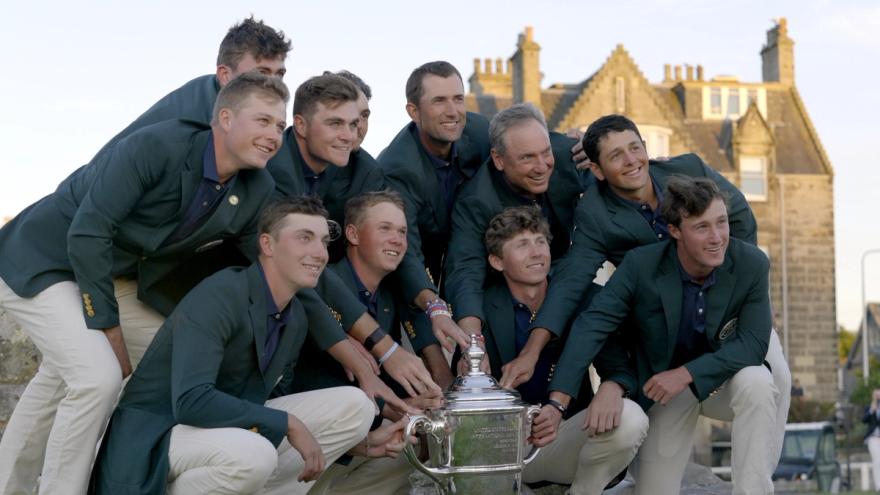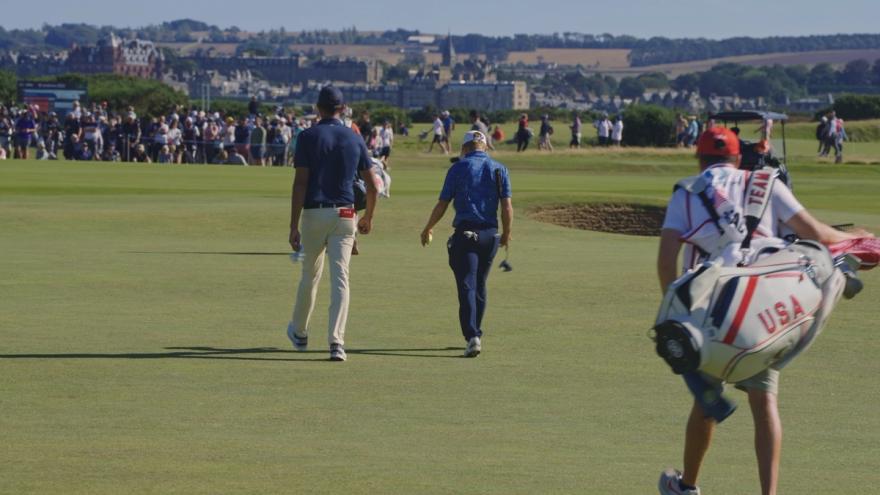A few centuries ago, the golf-obsessed people of St. Andrews, Scotland, made a seemingly counterintuitive decision. On Sundays, the historic grounds of The Old Course would outlaw golf and embrace its role as a space for public recreation. The course is open. But the course is closed.
It’s a tradition that – barring tournament play or extenuating circumstances – is still upheld today. Go for a run. Walk your dog. Have a picnic. Huck a frisbee. Do cartwheels over the Swilcan Bridge. Jump the burn. Let your kids build a sand castle in one of the Seven Sisters. Do whatever you want. Just respect the course and respect the rules: No golf.
I’ve been at The Old Course for one of these Sundays and the result is, in my opinion, a bucket list golf experience up there with any in the world. So much of the charm of The Old Course is the way it morphs, evolves and changes as you look at it from different angles. On one of these Sundays, you can grab a coffee, find a yardage book and go get lost out on the most interesting course in the world for as long as you want. No one is playing behind you.
Go look at that green from the other side!
Oh, that’s where Cam putted from on 17. Could I do that? I could do that.
Nah, I couldn’t do that.
At least for us Americans, the whole day carries with it a surreal feeling that can only be summed up as: “Should we really be doing this?” As you start out down the middle of the first fairway, you can’t help but look over your shoulder, waiting for a sprinting official from the St. Andrews Links Trust to tackle you for a 15-yard loss. But it doesn’t happen. The keepers of The Old Course look the other way for one day a week and trust that you aren’t going to screw it up for everyone else. And, for the most part, no one really has.
The reason I bring all this up is because that feeling is the closest approximation to what it was like last week at the Walker Cup, where fans on-site got an up-close look at the future of competitive golf through a lens that felt much more like the sport’s past.
(Pause: If you’re unfamiliar with the Walker Cup, here’s an overview of the event from myself and Wolfie. Despite a great start from the GB&I squad, the U.S. completed a comeback victory on the final day.)

I can’t believe I had never been to a Walker Cup. I still can’t believe they could all be like that – that chaotic, intimate and historic – but the people who make a point to attend each one insist that they are. That’s why they go.
Yes, there are technically ropes, held by volunteers who make sure competitors have enough space to execute shots. But after the ball is away, fans, players and caddies march toward the next shot together, shoulder-to-shoulder, before spectators form an unbroken circle around The Old Course’s massive double greens. You know that feeling of camping out behind a tee box for six groups just to have an eventual view of a Rory driver? At the Walker Cup, you get that view every time you want it.
I can’t believe that’s how golf tournaments used to be. That’s one of the big bittersweet feelings you take back with you. There are no life insurance activations or data-harvesting “fan villages.” You can hear conversations between players and caddies because you’re standing right next to them. There is no hierarchy of hospitality passes dangling from people’s necks – you look to your left and notice the chairman of Augusta National is out walking with the matches between a few St. Andrews University students. The more PGA Tour events you’ve been to in your life, the more surreal it is.
There was one mini grandstand overlooking the 11th tee. Even that seemed like it was there for altruistic reasons; not to sell A Premium Hospitality Experience, but to celebrate the fact that people in those seats could simultaneously see the 11th green, the seventh green, the 12th tee, the eighth green and the 10th green because The Old Course rules.
From an on-course perspective, the event contains absolutely no B.S. It is as pure-golf as it possibly gets in today’s world. (From a non-golf perspective, I’d listen to an argument that it’s almost entirely B.S. But I’m happy to ignore the hours of weepy speeches and cocktail receptions in exchange for such a fantastic and unique viewing experience.)
This type of atmosphere at a state high school tournament would be enough to make for an enjoyable day for anyone who loves watching golf. The fact that you’re instead watching future major champions dissect the best venues in the world makes it jump to the top of the list of best golf tournaments I’ve ever attended.
Because it can’t be said enough times: The venues leading up to last week’s event at The Old Course were National Golf Links, Royal Lytham, LACC, Hoylake and Seminole. The sites that have been announced going forward? Cypress Point, Lahinch, Bandon Dunes and Oakmont.
Mercy.
I can only speak to the experience I had last week while filming in St. Andrews, a place well-versed in hosting and trusting visitors. Who knows if Cypress Point will have the same laissez-faire attitude toward public fans roaming their hallowed grounds? And as this type of hyper-authentic experience goes extinct in the world of golf, who knows what the USGA will charge for tickets in order to keep it that way? (For what it’s worth, tickets at The Old Course were 20 pounds for the day and 35 for the week for the 14,000-plus that attended.)
But, man. If Cypress in 2025 is going to be one-tenth the experience that The Old Course was this year, it might be time to start looking at flights.
It’s an easy comparison to make, but in a year when so much of the conversation around competitive golf has been about purse sizes, guaranteed contracts, personal brands and congressional hearings, my god was it fun to just spend a week with great people watching great players on a great golf course.
Soon enough the bulk of those players will be at the center of all those things that are making pro golf increasingly less fun. But for this week at The Old Course, things remained uncomplicated.
I’m thankful we preserved as much as we could on the hard drives we brought home.
• • •
Some other observations from the week…
Hipster as it might sound, one of the best parts of watching this type of event at The Old Course was score in relation to par was totally irrelevant.
In major championships, we’re lucky to get to see The Old Course every five years or so. But each time The Open arrives, so much of the conversation around St. Andrews is about distance, protecting par and the invisible threat of 59’s desecrating golf’s holy land.
In the match-play format of The Walker Cup, all you really care about is who gets the ball in the hole first. I watched Gordon Sargent go 4-0 last week and have no idea whether he shot 58 or 68 in any of his rounds. I know he was able to use his prodigious length to put an immense amount of pressure on his opponent hole after hole. And I know he was playing a golf course that somehow had about six par 3s. But never once did it cross my mind where he stood in relation to par.
I’m not saying any of this is some solution to the distance discussion – having a little wedge into the Road Hole still evokes quite a funny feeling. What I’m saying is that The Old Course might have more thrilling half-par holes than any other course we see regularly and it was a great change of pace to actually see it in a match play context.
I think this, along with the microscopic logistical footprint of the event, is one of the reasons the USGA/R&A feels so confident continuing to take this event to iconic venues that are no longer realistic options for major championships. It seems like as good of a compromise as is possible in modern competitive golf.
• • •
Speaking of Sargent: I’m not sure what I can tell you that his rèsumè, his ball speed and his 4-0 record don’t say for him, but man it was cool to watch the No. 1 amateur in the world play The Old Course for a week straight.
Yes, the distance stuff was a thrill while he was goofing around in his practice rounds – he hit the stick with his tee shot on 18 one of the days, he drove the 414-yard sixth hole and he had a realistic chance to fly the burn at No. 1 (he came up just short). But once the actual event started, his demeanor, his shotmaking and his quiet confidence really did stand out on a team full of stud Americans.

After winning his match on Saturday evening, he talked about his process leading up to his final tee shot on 18.
“It would have been a perfect 3-wood,” he said. “But I would have had to start it out over the Russacks Hotel.” Instead, Sargent choked off a massive slice driver that rolled up and onto the putting surface to all but secure a point.
I also can’t express to you just how fast he plays. What a dream.
• • •
My favorite player to watch over the course of the week was 17-year-old Connor Graham from the GB&I team.
Graham was one of the youngest players to ever participate in the event and he had the look to prove it. When sitting his afternoon singles match on Saturday, walking around outside the ropes and watching his team, one fan (it was Randy) mistakenly thought he was a player’s younger brother that had found an extra uniform to show his support.
Graham’s curly blond hair, as well as his jittery demeanor on the course and a knack for holing some big, unlikely putts bore an uncanny resemblance to videos of young Jordan Spieth. It was all I could see after making the connection.
Graham absolutely held his own against some of the biggest U.S. names as well. He and countryman Calum Scott earned the first GB&I point of the week with a win in the first session. They then took the souped-up U.S. duo of Sargent and Nick Dunlap (the recent U.S. Am winner) all the way to the 18th, narrowly losing 1 down.
In a cruel joke from the golfing gods on the final day, Graham was matched up in singles against Stewart Hagestad, the oldest player on the U.S. side and by far the tallest on either team.
If I was going to show you one screenshot to try to explain why this event rules, it would probably be this one.

• • •
This is just a general match play note, but as the Solheim and Ryder Cups descend upon us, I have to think there are some other things to yell besides “come onnnn!” and “lesssss go!” when putts go in.
I’ll be thinking on this topic and encourage you to do the same.
• • •
Hagestad, 32, has now played on four Walker Cup teams and won all four of them.
Since most players who qualify for Walker Cup teams these days turn professional shortly after, Hagestad’s run is unusual, to say the least. He’s the 16th player in the history of the 100-plus-year-old event to have four wins to their name and the first in nearly 40 years (Jay Sigel) to win four in a row.
Hagestad wasn’t facing quite the same age gap that U.S. Captain Mike McCoy did while playing on the 2015 team, when he teed it up as a 52-year-old alongside teammates like Bryson DeChambeau (21), Denny McCarthy (22) and Maverick McNealy (19). But the difference between a 32-year-old golf history buff and a collection of 19 and 20-year-old college superstars was very fun to see up-close.
While Hagestad likely had much more in common with the investment bankers in iconic logos standing outside the ropes, it was fun to watch him pick his spots with his teammates and embrace his role as a pseudo vice captain. When the jet lag would hit guys mid-practice round, he would come up with three-hole games or challenges to keep teammates engaged. With the U.S. facing a 7.5 to 4.5 deficit heading into the final day, Hagestad opted to sit the morning session, despite a resounding 4 and 3 victory that afternoon.
“Our leader in the room was Stewart,” McCoy said. “And he stepped up and just said, ‘look, I'm not a great foursomes player, so I'm going to sit.’ That was pretty gracious on his part…I was planning on using him because he was playing so well.”
The older I’ve gotten, the more I’ve come around on the idea of having a designated mid-am player on the Walker Cup team and it was fun to see Hagestad show the game to back up his selection. He finished the week 2-1 after defeating Graham in the afternoon singles. As I write this, he’s making a run at his third U.S. Mid-Am title.
• • •
One of my favorite memories from this event will always be Saturday morning before the first match.
For the film project we were working on, I was waiting for one of the U.S. players to finish his physio work before following him to the first tee. So I grabbed a seat in the hallway outside the two team rooms, which were essentially just partitioned hotel conference/ballrooms.
Even at 7 in the morning, it’s hard to overstate the volume of the music that was blaring from the GB&I team room. I wish I could put my finger on how to describe the playlist. It wasn’t inspirational music, per se. It was just generally… happy... music that makes you want to sing along. Music that makes your shoulders a little less tense. “Crazy” by Gnarls Barkley. That sort of thing.
The GB&I players who left the team room were laughing and bouncing, almost arm-in-arm, seemingly carrying themselves to the first tee without a care in the world. By contrast, the U.S. players all had their own Beats headphones on, locked into their own world, their own processes and routines.
In an event where 18 of the 26 points are decided by singles matches, the U.S. talent advantage of course eventually flipped things in America’s favor. But damned if the GB&I team didn’t come out and win 3 of those first 4 matches.
It was impossible not to think of comparisons to the Ryder Cup and how the Europeans always seem to be playing a team event whereas the Americans often feel like individuals contributing to a team score.
I’m not saying it comes down to playlists or how loud your music is. Instead, it was just fascinating to see how innate that disconnect might be.
• • •
The reason we were at the Walker Cup was to shoot a “Week in the Life” video similar to the ones we did with the Stanford Women’s Golf Team and Madelene Sagström over the past few years. I still can’t really believe it happened and it’s a project we were able to take on because of the support of our Nest members.
Like those videos, I hope that this one – if we ever actually finish editing it – serves as a sort of public time capsule for a moment well-worth preserving.
The Walker Cup at The Old Course was one of those rare moments where history and potential crash together awkwardly and beautifully. The history being the story of golf’s greatest venue and even the origins of the sport itself. And the potential being the fact that one or two of the players you’re watching could very well change that history in the coming years in ways that are impossible to predict.
But that can wait. This week was for winning the event at hand, sure. But it was also for ping pong matches in the team room and realizing you’re not quite sure how to tie a tie. It was for being a teenager and a teammate, but also for filling up your yardage book for future Open Championships.
I went all the way to Scotland and didn’t hit a shot at The Old Course, but that’s OK. Sometimes it’s just as good to be able to walk the place and look around.